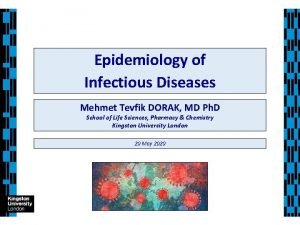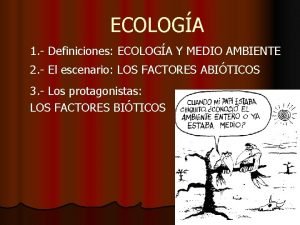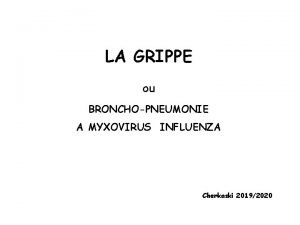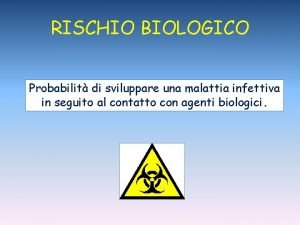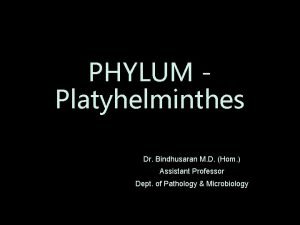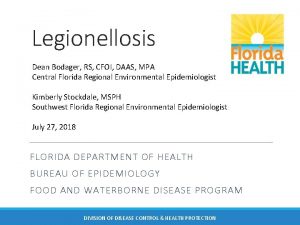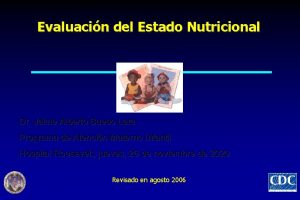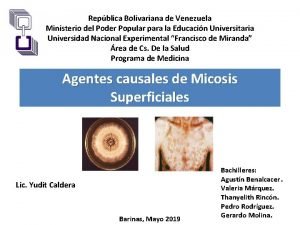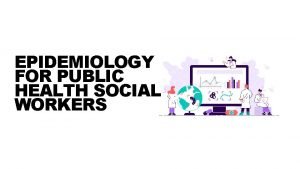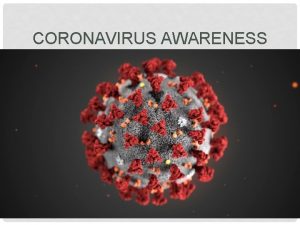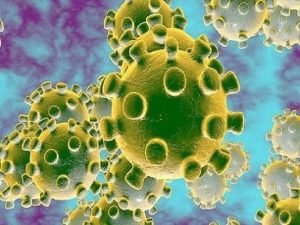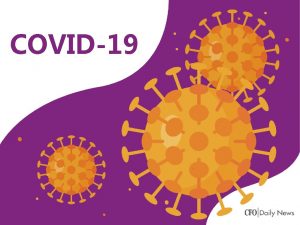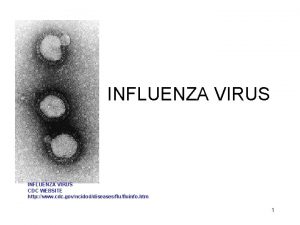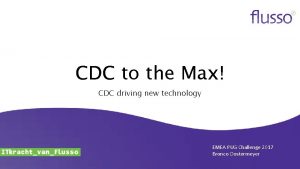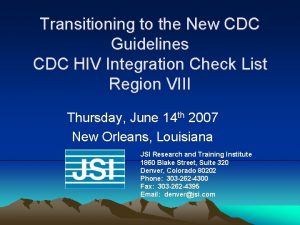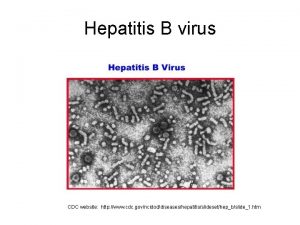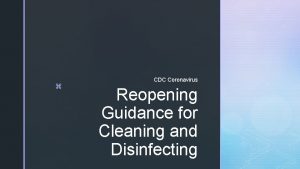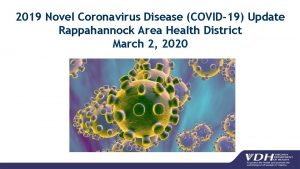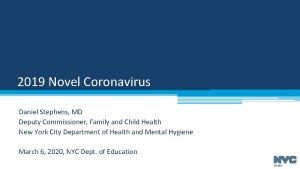CDC 2019 Novel Coronavirus Response Novel Coronavirus for
















- Slides: 16

CDC 2019 Novel Coronavirus Response Novel Coronavirus for Water Professionals Matthew J Arduino, MS, Dr. PH, FSHEA, M(ASCP) May 5, 2020 For more information: www. cdc. gov/COVID 19

COVID-19: Situation Overview § § WHO SITUATION REPORTS WHO COVID-2019 SIT REPS) US and Territories Daily Report US COVID DATA Tracker COVID-19 Weekly Surveillance Summary

COVID-19: Social Distancing § Also called “physical distancing”; keep space between yourself and others § Can help slow ongoing spread of respiratory illnesses, like COVID-19 § This can include: – Personal protective measures • Maintain 6 ft. from others in public • Stay home if exposed or sick – Community measures • Postpone or cancel mass gatherings • Dismissal of schools • Encourage telework cdc. gov/coronaviru s

Use of Cloth Face Coverings to Help Slow the Spread of COVID-19 § wear a cloth face covering to cover their nose and mouth in the community setting. § In situations where you may be near people § Not a substitute for social distancing § Not intended to protect the wearer, but it may prevent the spread of virus from the wearer to others https: //www. cdc. gov/coronavirus/2019 -ncov/prevent-getting-sick/diy-cloth-face-coverings. html

COVID-19: Shedding – Patients shed virus into their environment: • Primarily from respiratory tract • Stools have high PCR positivity (two reports from China have recovered culturable virus from small number of patients, but these have not been reproducible) • All healthcare contamination studies have been PCR based both air samples and surface samples. U Nebraska included culture in an attempt to recover infections virus but has not been successful to date. • Recent report from the Netherlands of RNA detected in wastewater and the possibility of using PCR as a surveillance tool

Fecal Shedding From Patients § The combination of very high virus RNA concentrations and occasional detection of sg. RNAcontaining cells in stool indicate active replication in the gastrointestinal tract § Our failure to isolate live SARS-Co. V-2 from stool may be due to the mild courses of cases, with only one case showing intermittent diarrhea § Further studies should therefore address whether SARS-Co. V-2 shed in stool is rendered non-infectious though contact with the gut environment § Initial results suggest that measures to contain viral spread should aim at droplet-, rather than fomitebased transmission. Wölfel R, et al. Virological assessment of hospitalized patients with COVID-2019. Nature 2020 [Published on line 1 April 2020] https: //doi. org/10. 1038/s 41586 -020 -2196 -x

Is Feces Infectious? § The risk of transmission of the virus that causes COVID-19 from the feces of an infected person is also unknown. § The risk is expected to be low based on data from previous outbreaks of related coronaviruses, such as severe acute respiratory syndrome (SARS) and Middle East respiratory syndrome (MERS). § There has been no confirmed fecal-oral transmission of COVID-19 to date.

Disease among Healthcare Workers § § Healthcare Workers account for 20% of all US acquired infections 9, 282 cases, 27 deaths Median age 42 years, 73% female 38% had at least 1 underlying condition https: //www. cdc. gov/mmwr/volumes/69/wr/pdfs/mm 6915 e 6 -H. pdf

CDC Updates § Symptoms § Interim Guidelines for Collecting, Handling, and Testing Clinical Specimens for Coronavirus Disease 2019 (COVID-19) § Testing in the United States § Groups at Higher Risk for Severe Illness § Cleaning and Disinfecting Your Facility § Use of Face Coverings to Slow the Spread § How to Protect Yourself § Resources for Businesses and Employers https: //www. cdc. gov/coronavirus/2019 -ncov/whats-new-all. html

SARS Co. V-2 RNA in Wastewater SARS-Co. V-2 in wastewater: potential health risk, but also data source. The Lancet Gastroenterology and Hepatology 1 April 2020, DOI: https: //doi. org/10. 1016/S 24681253(20)30087 -X Medema G, Heijnen L, Elsinga G, Italiaander R, Brouwer A. Presence of SARS-Coronavirus-2 in sewage. med. Rxiv 2020. 03. 29. 20045880 doi: https: //doi. org/10. 1101/2020. 03. 29. 2004 5880 § § § Data like most other environmental data is PCR based. PCR data alone from environmental samples means you found a sequence Does not indicate presence of intact virus Does not indicate presence of infectious virus. Authors suggest use for surveillance purposes

Strategies to Optimize PPE https: //www. cdc. gov/coronavirus/2019 -ncov/hcp/ppestrategy/index. html

Decontamination and Reuse of Filtering Facepiece Respirators § § UVGI Vapor phase hydrogen peroxide • • • § Hydrogen peroxide plasma • § § Battelle Decontamination System Bioquelle Vaprox Sterrad Moist heat (microwave; steam bag; without bag); moist heat incubation Ethylene oxide https: //www. cdc. gov/coronavirus/2019 -ncov/hcp/ppe-strategy/decontamination-reuse-respirators. html

COVID-19: Infection Prevention and Control § There are steps HCP can take to prepare for arrival, elevation and transportation of patients. – Healthcare Personnel Preparedness Checklist for COVID-19 – https: //www. cdc. gov/coronavirus/2 019 -ncov/hcp-personnelchecklist. html

COVID-19: Tools and Resources § Water and COVID FAQs – https: //www. cdc. gov/coronavirus/2019 -ncov/php/water. html § Healthcare Facilities – – – Ambulatory Care Services Guidance for Dental Settings Guidance for Nursing Homes and Long-Term Care Facilities Guidance for Dialysis Facilities Blood and Plasma Facilities § Supply of Personal Protective Equipment (PPE) – – Healthcare Supply of Personal Protective Equipment Strategies for Optimizing Supply of N 95 Respirators Decontamination and Reuse of Filtering Facepiece Respirators FAQ about Respirators

COVID-19: Tools and Resources (cont’d. ) § Home Care – Implementing Home Care of People Not Requiring Hospitalization – Preventing COVID-19 from Spreading in Homes and Communities – Disposition of Non-Hospitalized Patients with COVID-19 (ending home isolation) https: //www. cdc. gov/coronavirus/2019 -ncov/index. html COCA Calls/Webinars: https: //emergency. cdc. gov/coca/calls/index. asp

For more information, contact CDC 1 -800 -CDC-INFO (232 -4636) TTY: 1 -888 -232 -6348 www. cdc. gov The findings and conclusions in this report are those of the authors and do not necessarily represent the official position of the Centers for Disease Control and Prevention.
 Coronavirus
Coronavirus Bronquite coronavirus
Bronquite coronavirus Factores intraespecíficos
Factores intraespecíficos Scissurite coronavirus
Scissurite coronavirus Allegato xlvi del d.lgs. 81/08 coronavirus
Allegato xlvi del d.lgs. 81/08 coronavirus Relazione finale continuità infanzia primaria
Relazione finale continuità infanzia primaria Rischio biologico coronavirus | titolo x d.lgs. 81/08
Rischio biologico coronavirus | titolo x d.lgs. 81/08 Natural and forced response
Natural and forced response Natural response circuit
Natural response circuit Primary immune response and secondary immune response
Primary immune response and secondary immune response Oberschenkel
Oberschenkel Cdc plain language thesaurus
Cdc plain language thesaurus Facility manager
Facility manager Tablas cdc niños 2-20 años
Tablas cdc niños 2-20 años Cdc
Cdc Epidermophyton floccosum
Epidermophyton floccosum Cdc contact tracing
Cdc contact tracing
